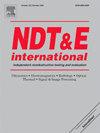High-quality, low-quantity: A data-centric approach to deep learning performance optimization in digital X-Ray radiography
IF 4.1
2区 材料科学
Q1 MATERIALS SCIENCE, CHARACTERIZATION & TESTING
引用次数: 0
Abstract
The accuracy of identifying defects using specialized deep learning models can be affected by the circumstances in which the training data is curated. This is especially evident in digital X-ray radiography, where the depiction of flaws is significantly impacted by the exposure conditions. This study examines the effect of curating high-quality data on deep learning models. The variation in contrast-to-noise ratio (CNR), which is a crucial metric of image quality between features of interest and an adjacent normal background, has been found to be a key factor in model generalization in digital X-ray radiography applications. By making systematic alterations to exposure conditions during data curation, it was possible to obtain several representations of flaws in each test component with varying contrast-to-noise ratios (CNR) in the resultant radiographs. To evaluate the efficacy of the model under various conditions, two distinct datasets were curated. Dataset 1 was obtained by acquiring images with a consistent exposure setting on 140 test samples. The samples contained 4 morphologically distinct classes of flat bottom holes with seven different depths and sizes. The contrast-to-noise ratio (CNR) representations of flaws in this dataset can be attributed only to differences in depth in Dataset 1. Additionally, Dataset 2 was curated with an expanded range of CNR values by methodically adjusting exposure settings during image acquisitions. Hence, only 42 % of the test pieces from Dataset 1, which had three distinct depths of flat bottom holes, were used. Each of the two datasets was used to separately train YOLOv8 for instance segmentation and U-net for multi-class semantic segmentation. Each model was trained under the same conditions, and their performances were assessed using test sets from both dataset groups. The model trained on Dataset 1 exhibited a notable decline in performance when evaluated on test sets from Dataset 2, suggesting a lack of generalization ability. Conversely, the model that was trained using Dataset 2 consistently achieved high accuracy on both test sets, demonstrating impressive performance and successful generalization. This work shows that the generalization abilities of deep learning models may be improved by varying the contrast-to-noise ratio (CNR) of features in the training data. This finding paves the way for practical applications in digital X-ray radiography.
求助全文
约1分钟内获得全文
求助全文
来源期刊

Ndt & E International
工程技术-材料科学:表征与测试
CiteScore
7.20
自引率
9.50%
发文量
121
审稿时长
55 days
期刊介绍:
NDT&E international publishes peer-reviewed results of original research and development in all categories of the fields of nondestructive testing and evaluation including ultrasonics, electromagnetics, radiography, optical and thermal methods. In addition to traditional NDE topics, the emerging technology area of inspection of civil structures and materials is also emphasized. The journal publishes original papers on research and development of new inspection techniques and methods, as well as on novel and innovative applications of established methods. Papers on NDE sensors and their applications both for inspection and process control, as well as papers describing novel NDE systems for structural health monitoring and their performance in industrial settings are also considered. Other regular features include international news, new equipment and a calendar of forthcoming worldwide meetings. This journal is listed in Current Contents.
 求助内容:
求助内容: 应助结果提醒方式:
应助结果提醒方式:


